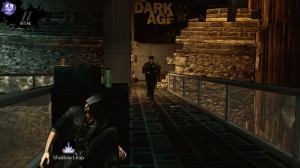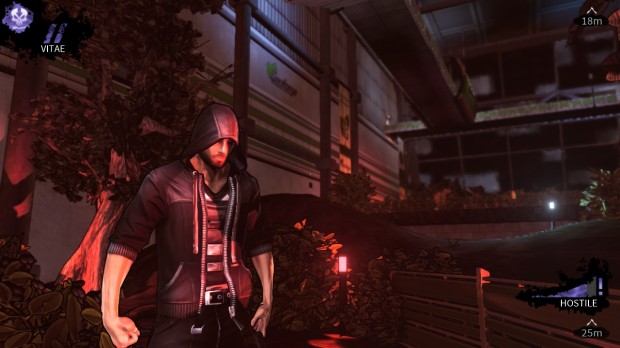More Dark Than Bite – Dark Review
Whether you love them or hate them, vampires (alongside zombies), are the most prominent monsters in modern-day horror. With films and TV shows such as Twilight and True Blood, though, their sense of danger and darkness has been eroded somewhat, giving them a more brooding and darkly romantic air, rather than their traditionally murderous and terrifying reputation, such as in Stephen King’s Salem’s Lot. Dark, which comes from Realmforge Studios and is published by Kalypso Media, attempts to return vampires to the shadows in a third-person stealth adventure full of blood-sucking, creeping in the darkness, and awesome supernatural powers.
Dark tells the story of Eric Bane, a recently turned vampire, who finds himself in a vampire-run nightclub, having no memory of how he came to be there. In Dark’s lore, once bitten, a victim is only turned into a fledgling vampire, with full vampire status only being granted once the new vampire has drunk the blood of the original vampire that bit them in the first place. If this doesn’t occur, then the fledgling vampire slowly degenerates into a Ghoul, a mindless animal who seeks only to feed. With the help of Rose and Tom, two established vampires, Eric drinks (blood, not alcohol) his way through the city, attempting to become full-vampire before the inevitable slide into Ghoul status takes place.
 Taking the form of a third-person stealth adventure, Dark takes players through museums, office buildings and slums (amongst other places), as Eric attempts to find out just what he was doing before he got bitten. Much of the story comes from Eric’s monologues, which bookend each chapter, and sound a lot like the monologues featured in the Max Payne series, from the gruff delivery to the hardboiled subject matter. However, Eric’s delivery sounds a lot more disconnected that Max’s, to the extent that most of these monologues sound like someone is reading each sentence of a sheet in isolation from each other, rather than attempting to form a cohesive segment of speech. In fact, voice acting as a whole throughout Dark is one of the game’s biggest weaknesses, with conversations sounding as if they are happening between two disconnected participants, and some sentences being delivered so flatly and lacking in emotion that it’s entirely possible to miss the point of what’s being said.
Taking the form of a third-person stealth adventure, Dark takes players through museums, office buildings and slums (amongst other places), as Eric attempts to find out just what he was doing before he got bitten. Much of the story comes from Eric’s monologues, which bookend each chapter, and sound a lot like the monologues featured in the Max Payne series, from the gruff delivery to the hardboiled subject matter. However, Eric’s delivery sounds a lot more disconnected that Max’s, to the extent that most of these monologues sound like someone is reading each sentence of a sheet in isolation from each other, rather than attempting to form a cohesive segment of speech. In fact, voice acting as a whole throughout Dark is one of the game’s biggest weaknesses, with conversations sounding as if they are happening between two disconnected participants, and some sentences being delivered so flatly and lacking in emotion that it’s entirely possible to miss the point of what’s being said.
The voice-acting isn’t helped by either the writing or the animation, either. Characters frequently repeat what they’ve already said, or what’s just been told to them, as if they’ve already forgotten what’s happened in the conversation, and the character models themselves seem to stare off into the distance while talking, with little to no mouth movement to indicate which character is actually speaking. It almost gets to the point of characters interrupting each other as well, as the pacing of conversations is so off that some lines start almost immediately after the previous line has ended, way before the usual range of human reaction speeds would allow someone to process what’s just been said. When characters are granted the chance to have some form of bodily expression, they jerk between pre-programmed animations, with one particular instance of Eric going from head-in-hands despair to standing upright seemingly instantaneously.
 It’s a shame, because visually, Dark is quite unique compared to a lot of other games. Taking on a cel-shaded design, more like Crackdown than Borderlands, Dark does a good job of conveying the shadowy and seedy underworld that vampires would theoretically reside in. There is a good variety of evenly transitioned settings within the game as well, starting from Sanctuary, the vampire nightclub, and working its way through the Medieval exhibit of a local museum, through to indoor parks and laboratories. Each chapter is set up in a way that appeals to a stealthy playstyle as well, with plenty of blind corners and chances to sneak through undetected. There are also PDAs scattered about the place (glowing devices that give background information regarding the wider story surrounding Eric), which offer some intriguing clues that provide foreshadowing, allowing the player to guess at what’s going on before the big reveal in the later stages.
It’s a shame, because visually, Dark is quite unique compared to a lot of other games. Taking on a cel-shaded design, more like Crackdown than Borderlands, Dark does a good job of conveying the shadowy and seedy underworld that vampires would theoretically reside in. There is a good variety of evenly transitioned settings within the game as well, starting from Sanctuary, the vampire nightclub, and working its way through the Medieval exhibit of a local museum, through to indoor parks and laboratories. Each chapter is set up in a way that appeals to a stealthy playstyle as well, with plenty of blind corners and chances to sneak through undetected. There are also PDAs scattered about the place (glowing devices that give background information regarding the wider story surrounding Eric), which offer some intriguing clues that provide foreshadowing, allowing the player to guess at what’s going on before the big reveal in the later stages.
Dark features some RPG-lite elements as well, in that you gain experience for killing enemies, with a bonus for killing those that are unaware of your presence. In keeping with the game’s stealth mandate, players gain a sizeable bonus for completing an area without any enemies raising the alarm, providing a good incentive to stick to the shadows. For every 1000 experience points that players collect, they unlock a Power Point, which goes towards attaining or improving supernatural powers for Eric. These are broken down into three sections, such as Inherent, which includes abilities such as Feed, or Shadow Leap (a short-range teleport ability), Vampiric, which allows for Domination (mind-control) or Regeneration (healing) and Passive, which includes Vitae and Toughness. Vitae is the currency with which Eric can use his powers, and is gained by feeding on enemies. You can feed on most enemies in the game, but it takes a lot longer than merely killing them, and is also noisier, which raises the chances of being detected by nearby enemies. It’s a risk vs. reward system that encourages you to take chances now in order to have an easier time of it later, when you can use your powers to take out enemies a lot quicker than when using your bare hands alone.
For a stealth game, Dark has a lot of mechanical issues that makes the experience a lot less smooth and a lot more frustrating than a stealth experience typically should be. Once an enemy has been downed, you have the option (and it’s widely recommended within game), to drag their corpse out of sight so that other enemies don’t spot that you’re slowly taking out their comrades. Unfortunately, the drag button doesn’t always trigger properly, costing valuable seconds when you have an enemy approaching to see what all the fuss is about. Additionally, bodies frequently get caught on scenery while being dragged, and sometimes even get caught in the scenery itself, making detection all but inevitable. What’s more, there were a number of opportunities where once an enemy had spotted a body, they walk over to investigate, and get themselves caught within the parameters of the body, their legs flailing back and forth in a seeming parody of an Irish jig as they attempt to break free .
When you do finally get spotted, which happens more than you’d like, you’ll find that combat is just as frustrating as attempting to avoid it, especially considering that Eric has a habit of ‘wandering’ following cutscenes, often walking right out of cover without any controller input. Though enemies are able to knock Eric’s attacks back, you’ll find that your biggest obstacle is the game itself, as sometimes it plain refuses to recognise that you’ve hit the attack button, even when you’re face-on to a targeted enemy, and within less than a few feet away from them. And when combat does trigger, Eric’s attacks are way out of context for the stealth environment that the game is trying to create, with teleports and noisy backflip kicks being Eric’s kill-move of choice, even before an enemy has triggered an alarm. If you thought Ellie was unsubtle in The Last of Us, it’s even worse when the player-controlled protagonist starts gratuitously making noise when you’re trying to sneak.
Aside from the mechanical problems, Dark actually includes some good ideas, not least of which is the variation in obstacles that you’ll have to face when sneaking around. These range from the usual military-grade motion detectors and security cameras, to civilian staff who Eric is not allowed to kill and will alert guards to your presence. Perhaps the best obstacles, though, are the contextual ones, such as the motion-triggered information booths in the museum stages. They’re still deadly, as enemies will come running as soon as one is set off, but they fit the setting well, and at least you’ll hear some interesting information while you’re being annihilated. These information booths actually provide a good analogy for the game as a whole. They only make up a small part of the game, but they work well. Dark, in general, is the same, in that there’s a lot wrong with the game, but when it works, you get a great sense of power in sneaking around and taking out enemies with a mixture of stealth and paranormal abilities. One thing I would have loved to have seen was the ability to drag enemies into the shadows when feeding on them, but as it is, Eric is granted a wide range of useful powers that serve him well, and it’s a shame that the surrounding game doesn’t quite live up to this strong fallback.
 Although Dark doesn’t track reload times when calculating your completion time for the game, my clock read around six hours by the time I’d finished the narrative, having seen both endings. In reality, this time would be more like eight hours if reloads were taken into account, meaning that there’s a far amount of gaming to be done here for those who want to check out this vampire tale. There are a lot of issues with the game, most of which prove quite frustrating and almost border on unfair, but Realforge Studios is at least attempting something different when viewed as part of the larger videogaming scene, especially in terms of visuals and theme. The experiment doesn’t really come off, unfortunately, but those looking for something a little darker, or a little more varied than your typical AAA title, may just find something to sink their teeth into with Dark, so long as they’re wary of being bitten themselves.
Although Dark doesn’t track reload times when calculating your completion time for the game, my clock read around six hours by the time I’d finished the narrative, having seen both endings. In reality, this time would be more like eight hours if reloads were taken into account, meaning that there’s a far amount of gaming to be done here for those who want to check out this vampire tale. There are a lot of issues with the game, most of which prove quite frustrating and almost border on unfair, but Realforge Studios is at least attempting something different when viewed as part of the larger videogaming scene, especially in terms of visuals and theme. The experiment doesn’t really come off, unfortunately, but those looking for something a little darker, or a little more varied than your typical AAA title, may just find something to sink their teeth into with Dark, so long as they’re wary of being bitten themselves.
About This Post

